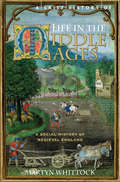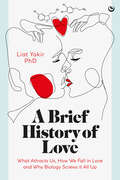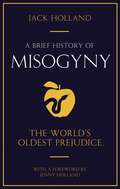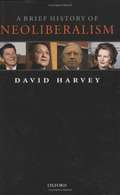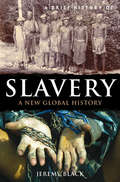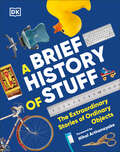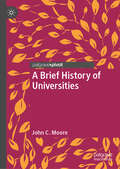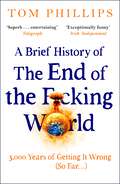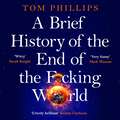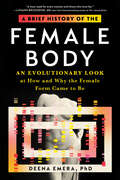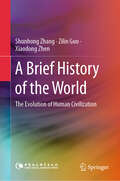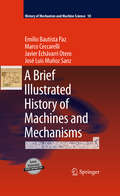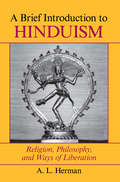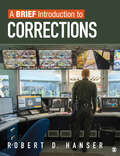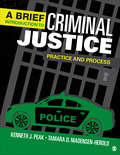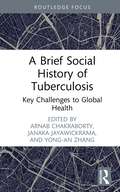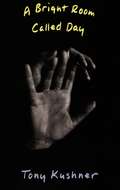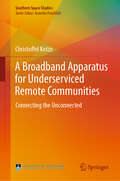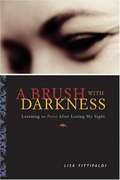- Table View
- List View
A Brief History of Life in the Middle Ages (Brief Histories)
by Martyn WhittockUsing wide-ranging evidence, Martyn Whittock shines a light on Britain in the Middle Ages, bringing it vividly to life in this fascinating new portrait that brings together the everyday and the extraordinary.Thus we glimpse 11th-century rural society through a conversation between a ploughman and his master.The life of Dick Whittington illuminates the rise of the urban elite. The stories of Roger 'the Raker' who drowned in his own sewage, a 'merman' imprisoned in Orford Castle and the sufferings of the Jews of Bristol reveal the extraordinary diversity of medieval society. Through these characters and events - and using the latest discoveries and research - the dynamic and engaging panorama of medieval England is revealed.
A Brief History of Love: What Attracts Us, How We Fall in Love and Why Biology Screws it All Up
by Liat YakirIs love about chemistry or do biology, evolution and psychology all have a part to play?Love is one of the most complex and confusing emotions in the human experience. It consumes so much of our lives and yet we don&’t truly understand it – what it is on a biological, chemical and evolutionary level. This book takes you on a fascinating journey to explore the science of love, looking closely at the interplay between genes, hormones, emotions and relationships.Discover everything you need to know about why you are attracted to certain people, the brain&’s role in your emotions, how to pick &“the one&” and how to preserve that love over time. Learn how to have better, healthier and more loving relationships by understanding the inner workings of love in your body.
A Brief History of Misogyny: The World's Oldest Prejudice
by Jack HollandIn this compelling, powerful book, highly respected writer and commentator Jack Holland sets out to answer a daunting question: how do you explain the oppression and brutalization of half the world's population by the other half, throughout history? The result takes the reader on an eye-opening journey through centuries, continents and civilizations as it looks at both historical and contemporary attitudes to women. Encompassing the Church, witch hunts, sexual theory, Nazism and pro-life campaigners, we arrive at today's developing world, where women are increasingly and disproportionately at risk because of radicalised religious belief, famine, war and disease. Well-informed and researched, highly readable and thought-provoking, this is no outmoded feminist polemic: it's a refreshingly straightforward investigation into an ancient, pervasive and enduring injustice. It deals with the fundamentals of human existence -- sex, love, violence -- that have shaped the lives of humans throughout history. The answer? It's time to recognize that the treatment of women amounts to nothing less than an abuse of human rights on an unthinkable scale. A Brief History of Misogyny is an important and timely book that will make a long-lasting contribution to the efforts to improve those rights throughout the world.
A Brief History of Misogyny: The World's Oldest Prejudice (Brief Histories)
by Jack HollandIn this compelling, powerful book, highly respected writer and commentator Jack Holland sets out to answer a daunting question: how do you explain the oppression and brutalization of half the world's population by the other half, throughout history? The result takes the reader on an eye-opening journey through centuries, continents and civilizations as it looks at both historical and contemporary attitudes to women. Encompassing the Church, witch hunts, sexual theory, Nazism and pro-life campaigners, we arrive at today's developing world, where women are increasingly and disproportionately at risk because of radicalised religious belief, famine, war and disease. Well-informed and researched, highly readable and thought-provoking, this is a refreshingly straightforward investigation into an ancient, pervasive and enduring injustice. It deals with the fundamentals of human existence -- sex, love, violence -- that have shaped the lives of humans throughout history. The answer? It's time to recognize that the treatment of women amounts to nothing less than an abuse of human rights on an unthinkable scale. A Brief History of Misogyny is an important and timely book that will make a long-lasting contribution to the efforts to improve those rights throughout the world.
A Brief History of Neoliberalism
by David HarveyNeoliberalism - the doctrine that market exchange is an ethic in itself, capable of acting as a guide for all human action - has become dominant in both thought and practice throughout much of the world since 1970 or so. Its spread has depended upon a reconstitution of state powers such that privatization, finance, and market processes are emphasized. State interventions in the economy are minimized, while the obligations of the state to provide for the welfare of its citizens are diminished. David Harvey, author of 'The New Imperialism' and 'The Condition of Postmodernity', here tells the political-economic story of where neoliberalization came from and how it proliferated on the world stage. While Thatcher and Reagan are often cited as primary authors of this neoliberal turn, Harvey shows how a complex of forces, from Chile to China and from New York City to Mexico City, have also played their part. In addition he explores the continuities and contrasts between neoliberalism of the Clinton sort and the recent turn towards neoconservative imperialism of George W. Bush. Finally, through critical engagement with this history, Harvey constructs a framework not only for analyzing the political and economic dangers that now surround us, but also for assessing the prospects for the more socially just alternatives being advocated by many oppositional movements.
A Brief History of Slavery: A New Global History (Brief Histories )
by Jeremy BlackA thought-provoking and important book that raises essential issues crucial not only for our past but also the present day.In this panoramic history, Jeremy Black tells how slavery was first developed in the ancient world, and reaches all the way to present day and the contemporary crimes of trafficking and bonded labour. He shows how slavery has taken many forms throughout history and across the world - from the uprising of Spartacus, the plantations of the Indies, and the murderous forced labour of the gulags and concentration camps.Slavery helped consolidated transoceanic empires and helped mould new world societies such as America and Brazil. In the Atlantic trade, Black also looks at the controversial area of how complicit the African peoples were in the trade. He then charts the long fight for abolition in the 19th century, including both the campaigners as well as the lost voices of the slaves themselves who spoke of their misery.Finally, as Black points out, slavery has not been completely abolished today and coerced labour can be found closer to home than is comfortable.
A Brief History of Slavery: A New Global History (Brief Histories)
by Jeremy BlackA thought-provoking and important book that raises essential issues crucial not only for understanding our past but also the present day.In this panoramic history, Jeremy Black tells how slavery was first developed in the ancient world, and reaches all the way to the present in the form of contemporary crimes such as trafficking and bonded labour. He shows how slavery has taken many forms throughout history and across the world - from the uprising of Spartacus, the plantations of the West Indies, and the murderous forced labour of the gulags and concentration camps.Slavery helped to consolidate transoceanic empires and helped mould new world societies such as America and Brazil. Black charts the long fight for abolition in the nineteenth century, looking at both the campaigners as well as the harrowing accounts of the enslaved themselves.Slavery is still with us today, and coerced labour can be found closer to home than one might expect.
A Brief History of Stuff: The Extraordinary Stories of Ordinary Objects
by DKLearn how 30,000 bath toys and the work of amateur beachcombers have helped scientists study ocean currents. Explore how the search for a death ray led to the creation of the microwave oven and ready-made meals. Discover the surprising link between sticky tape and the Nobel Prize. Uncover the extraordinary stories of ordinary objects in this perfect gift for curious minds. From the creators of the A Brief History of Stuff podcast and inspired by the incredible artifacts in the Science Museum Group Collection, this collection of entertaining essays reveals the fascinating history behind some of the most mundane items in our homes.
A Brief History of Universities
by John C. MooreIn this book, John C. Moore surveys the history of universities, from their origin in the Middle Ages to the present. Universities have survived the disruptive power of the Protestant Reformation, the Scientific, French, and Industrial Revolutions, and the turmoil of two world wars—and they have been exported to every continent through Western imperialism. Moore deftly tells this story in a series of chronological chapters, covering major developments such as the rise of literary humanism and the printing press, the “Berlin model” of universities as research institutions, the growing importance of science and technology, and the global wave of campus activism that rocked the twentieth century. Focusing on significant individuals and global contexts, he highlights how the university has absorbed influences without losing its central traditions. Today, Moore argues, as universities seek corporate solutions to twenty-first-century problems, we must renew our commitment to a higher education that produces not only technicians, but citizens.
A Brief History of the End of the F*cking World: The hilarious and fascinating new book from the international bestselling author of HUMANS
by Tom PhillipsDo you feel like we're living in the end times? Does it seem like everything is on fire, and one disaster follows another? Here's a small comfort: you're not the first to feel that way. If there's one thing that people throughout history have agreed on, it's that history wasn't going to be around for much longer.This book is about the apocalypse, and how humans have always believed it to be very f*cking nigh. Across thousands of years, we'll meet weird cults, failed prophets and mass panics, holy warriors leading revolts in anticipation of the last days, and suburbanites waiting for aliens to rescue them from a doomed Earth. We'll journey back to the 'worst period to be alive', as the world reeled from a simultaneous pandemic and climate crisis. And we'll look to the future to ask the unnerving question: how might it all end?But it's also a book about how we live in a world where catastrophe is always looming - whether it's a madman with a nuclear button or the slow burn of environmental collapse. Because when we talk about the end of the world, what we really mean is the end of our world. Our obsession with doomsday is really about change: our fear of it, and our desire for it, and how - ultimately - we can find hope in it.Praise for the Brief History series:'Uproarious . . . Abundant good humour' The Times'Witty, entertaining and slightly distressing... You should probably read it' Sarah Knight, author of The Life-Changing Magic of Not Giving a F*ck'Brilliant. Utterly, utterly brilliant' Jeremy Clarkson'Very funny' Mark Watson'Both readable and entertaining' Telegraph
A Brief History of the End of the F*cking World: The hilarious and fascinating new book from the international bestselling author of HUMANS
by Tom PhillipsDo you feel like we're living in the end times? Does it seem like everything is on fire, and one disaster follows another? Here's a small comfort: you're not the first to feel that way. If there's one thing that people throughout history have agreed on, it's that history wasn't going to be around for much longer.This book is about the apocalypse, and how humans have always believed it to be very f*cking nigh. Across thousands of years, we'll meet weird cults, failed prophets and mass panics, holy warriors leading revolts in anticipation of the last days, and suburbanites waiting for aliens to rescue them from a doomed Earth. We'll journey back to the 'worst period to be alive', as the world reeled from a simultaneous pandemic and climate crisis. And we'll look to the future to ask the unnerving question: how might it all end?But it's also a book about how we live in a world where catastrophe is always looming - whether it's a madman with a nuclear button or the slow burn of environmental collapse. Because when we talk about the end of the world, what we really mean is the end of our world. Our obsession with doomsday is really about change: our fear of it, and our desire for it, and how - ultimately - we can find hope in it.Praise for the Brief History series:'Uproarious . . . Abundant good humour' The Times'Witty, entertaining and slightly distressing... You should probably read it' Sarah Knight, author of The Life-Changing Magic of Not Giving a F*ck'Brilliant. Utterly, utterly brilliant' Jeremy Clarkson'Very funny' Mark Watson'Both readable and entertaining' Telegraph
A Brief History of the End of the F*cking World: The hilarious and fascinating new book from the international bestselling author of HUMANS (Brief Histories Series)
by Tom PhillipsDo you feel like we're living in the end times? Does it seem like everything is on fire, and one disaster follows another? Here's a small comfort: you're not the first to feel that way. If there's one thing that people throughout history have agreed on, it's that history wasn't going to be around for much longer.This book is about the apocalypse, and how humans have always believed it to be very f*cking nigh. Across thousands of years, we'll meet weird cults, failed prophets and mass panics, holy warriors leading revolts in anticipation of the last days, and suburbanites waiting for aliens to rescue them from a doomed Earth. We'll journey back to the 'worst period to be alive', as the world reeled from a simultaneous pandemic and climate crisis. And we'll look to the future to ask the unnerving question: how might it all end?But it's also a book about how we live in a world where catastrophe is always looming - whether it's a madman with a nuclear button or the slow burn of environmental collapse. Because when we talk about the end of the world, what we really mean is the end of our world. Our obsession with doomsday is really about change: our fear of it, and our desire for it, and how - ultimately - we can find hope in it.Praise for the Brief History series:'Uproarious . . . Abundant good humour' The Times'Witty, entertaining and slightly distressing... You should probably read it' Sarah Knight, author of The Life-Changing Magic of Not Giving a F*ck'Brilliant. Utterly, utterly brilliant' Jeremy Clarkson'Very funny' Mark Watson'Both readable and entertaining' Telegraph
A Brief History of the Female Body: An Evolutionary Look at How and Why the Female Form Came to Be
by Dr. Deena EmeraFrom breasts and orgasms to periods, pregnancies, and menopause—A Brief History of the Female Body is a fascinating science book explaining the mysteries of the female body through an evolutionary lens.Let's face it: The female body is an enigma. For teenagers first experiencing their periods, the monthly arrival of mood swings and cramps can be agonizing and inconvenient. With pregnancy—perhaps the most miraculous of bodily events—comes countless potential complications, including high blood pressure, diabetes, premature birth, and postpartum depression. And menopause is equally mystifying. Why do females lose their fertility over time and experience the notorious side effects—like hot flashes, weight gain, and hair loss—while males maintain their fertility forever?Evolutionary geneticist and educator Dr. Deena Emera has spent much of her career studying the evolution of female reproduction. A Brief History of the Female Body draws on her vast expertise as a biologist, her experience as a mother of four children, and her love of teaching to look far into our evolutionary past, illuminating how and, more importantly, why the female form has transformed over millions of years and its effects on women's health.
A Brief History of the World: The Evolution of Human Civilization
by Shunhong Zhang Zilin Guo Xiaodong ZhenThis book sets forth the historical lines from primitive society, through slave society, feudal society and capitalist society, to socialist society, and from Stone Age to information era with brief words and colorful images, and also clarifies the evolution from the relative isolation to close connection between countries in different parts in the world. This book strives to present scientifically the development processes and interrelations of all parts of the world based on plentiful data and objective materials and reveal the contributions on the human civilization process from all civilizations and the glorious way to the human community with a shared future.
A Brief Illustrated History of Machines and Mechanisms (History of Mechanism and Machine Science #10)
by Marco Ceccarelli Emilio Bautista Paz Javier Echávarri Otero José Luis Muñoz SanzThis work deals with mechanical manufacturing processes in history, examined through the machines associated with those processes. A tool is only included if it is part of a machine tool, with devices made up of moving parts. Once the analytical field has been marked out, the chosen descriptive method is basically graphic. This historical compendium attempts to give a wide-angle view of historical development without making an in-depth analysis of each of the examples presented. Moreover, this book illustrates the historical development of machines and mechanisms more from a technical point of view rather than a strictly history of science point of view since the authors are mechanical engineers who are interested and motivated to examine the most significant facts in their own area of knowledge of the Theory of Machines and Mechanisms. A full understanding of the historical development of Technology also needs the help of experts in technical matters who can appreciate and reassess bygone achievements in the light of their own technical knowledge. More collaboration between science historians and technical experts is needed, as is currently the case in the field of Industrial Archaeology. Thus, this book is also an attempt to set out a technical approach to the historical development of machines and mechanisms, but without too many technical details that will prevent its understanding being purely historical. At the beginning of each chapter there is a global reference to the period embraced, the most relevant facts, and the most significant treatises in the context of machine history. Following this introduction each chapter contains a series of sections on the types of machines that are representative of the period analysed together with illustrations to accompany the text. A fairly extensive bibliography enables the reader to make a deeper historical analysis.
A Brief Introduction To Hinduism: Religion, Philosophy, And Ways Of Liberation
by A. L. Herman“I have read Arthur Herman’s Introduction to Hinduism with considerable interest and pleasure. It is bold and innovative, clearly written, well organized, and quite provocative.” —Eliot Deutsch University of Ha wail at Manoa
A Brief Introduction to Corrections
by Robert D. HanserA Brief Introduction to Corrections is a condensed version of the best-selling Introduction to Corrections by Robert D. Hanser. This new text provides students with an overview of corrections that is both practitioner-driven and grounded in modern research. Experienced correctional practitioner and scholar Robert D. Hanser shows readers how the corrections system actually works, from classification to security and treatment to demonstrating how and why correctional practices are implemented.
A Brief Introduction to Corrections
by Robert D. HanserA Brief Introduction to Corrections is a condensed version of the best-selling Introduction to Corrections by Robert D. Hanser. This new text provides students with an overview of corrections that is both practitioner-driven and grounded in modern research. Experienced correctional practitioner and scholar Robert D. Hanser shows readers how the corrections system actually works, from classification to security and treatment to demonstrating how and why correctional practices are implemented.
A Brief Introduction to Criminal Justice: Practice and Process
by Dr. Kenneth J. Peak Tamara D. Madensen-HeroldA Brief Introduction to Criminal Justice: Practice and Process is a condensed version of the best-selling Introduction to Criminal Justice: Practice and Process by Kenneth J. Peak and Tamara D. Madensen-Herold. This new text uses a practical, applied approach to teach students the foundations of the U.S. criminal justice system in a concise and accessible format. The authors draw on their many years of combined practitioner and academic experience to explain the importance of criminal justice and show how key trends, emerging issues, and practical lessons can be applied in the field. INSTRUCTORS: A Brief Introduction to Criminal Justice: Practice and Process is accompanied by a complete teaching and learning package! Contact your rep to request a demo. SAGE vantage Digital Option SAGE vantage is an intuitive digital platform that delivers this text&’s content in a learning experience carefully designed to ignite student engagement and drive critical thinking. Built with you and your students in mind, it offers easy course set-up and enables students to better prepare for class. Contact your rep to learn more. SAGE Premium Video SAGE Premium Video includes original Student on the Street videos and Criminal Justice in Practice videos that boost comprehension and bolster analysis. Watch a sample SAGE coursepacks Intuitive and simple to use, SAGE coursepacks makes it easy to import our quality instructor and student resource content into your school&’s learning management system (LMS). SAGE edge This companion website offers students a robust online environment with an impressive array of teaching and learning resources.
A Brief Introduction to Criminal Justice: Practice and Process
by Dr. Kenneth J. Peak Tamara D. Madensen-HeroldA Brief Introduction to Criminal Justice: Practice and Process is a condensed version of the best-selling Introduction to Criminal Justice: Practice and Process by Kenneth J. Peak and Tamara D. Madensen-Herold. This new text uses a practical, applied approach to teach students the foundations of the U.S. criminal justice system in a concise and accessible format. The authors draw on their many years of combined practitioner and academic experience to explain the importance of criminal justice and show how key trends, emerging issues, and practical lessons can be applied in the field. INSTRUCTORS: A Brief Introduction to Criminal Justice: Practice and Process is accompanied by a complete teaching and learning package! Contact your rep to request a demo. SAGE vantage Digital Option SAGE vantage is an intuitive digital platform that delivers this text&’s content in a learning experience carefully designed to ignite student engagement and drive critical thinking. Built with you and your students in mind, it offers easy course set-up and enables students to better prepare for class. Contact your rep to learn more. SAGE Premium Video SAGE Premium Video includes original Student on the Street videos and Criminal Justice in Practice videos that boost comprehension and bolster analysis. Watch a sample SAGE coursepacks Intuitive and simple to use, SAGE coursepacks makes it easy to import our quality instructor and student resource content into your school&’s learning management system (LMS). SAGE edge This companion website offers students a robust online environment with an impressive array of teaching and learning resources.
A Brief Social History of Tuberculosis: Key Challenges to Global Health
by Arnab Chakraborty Janaka Jayawickrama Yong-An ZhangA Brief Social History of Tuberculosis delves into the history of tuberculosis and its impact on human populations.Drawing on research and expert experiences, the three research chapters (3–5) will explore how the disease has affected communities throughout history, and how society has responded to the threat of tuberculosis over time. Tuberculosis has been a persistent and devastating force from the crowded cities of the Industrial Revolution to the present day. However, this book will argue that there is much to be learned from the successes and failures of past efforts to control the disease from a social perspective. By examining the history of tuberculosis, researchers and policymakers can gain valuable insights into the challenges of infectious disease control, as well as the social and political factors that shape our response to such challenges.This volume will focus on generating critical discussions among scholars, researchers, and policymakers: it will be informative, engaging, and an essential read for anyone interested in the history of medicine, public health, and the ongoing struggle against infectious diseases worldwide.
A Bright Room Called Day
by Tony KushnerFrom the Pulitzer Prize-winning author of Angels in America comes this powerful portrayal of individual dissolution and resolution in the face of political catastrophe."It's brash, audacious and...intoxicatingly visionary."--Sid Smith, Chicago Tribune
A Broadband Apparatus for Underserviced Remote Communities: Connecting the Unconnected (Southern Space Studies)
by Christoffel KotzeThis book investigates how broadband internet can be provided to remote and isolated communities through the use of satellite and other enabling technologies, in the form of a self-contained broadband apparatus. It discusses how the proposed design can help bridge the digital divide by removing one of the main hurdles to adopting technologies: infrastructure. In turn, the book explores how the lack of infrastructure, especially with regard to connectivity and electricity, can be addressed by exploiting new technological advances in a number of fields, notably the newly proposed large broadband satellite constellations. In closing, it uses concrete examples to demonstrate the potential positive impacts of a “broadband ecosystem” on economics, governance and society, and on achieving the United Nations’ Sustainable Development Goals.
A Brush With Darkness: Learning to Paint After Losing My Sight
by Lisa FittipaldiWhen Lisa Fittipaldi went blind at the age of forty-seven, she descended into a freefall of anger and denial that lasted for two years. In this moving memoir, she paints a vivid picture of the perceptual and emotional darkness that accompanied her vision loss, and her arduous journey back into the sighted world through mastery of the principles of art and color.
A Buddhist Theory of Killing: A Philosophical Exposition
by Martin KovanThis book provides a philosophical account of the normative status of killing in Buddhism. Its argument theorises on relevant Buddhist philosophical grounds the metaphysical, phenomenological and ethical dimensions of the distinct intentional classes of killing, in dialogue with some elements of Western philosophical thought. In doing so, it aims to provide a descriptive account of the causal bases of intentional killing, a global justification and elucidation of Buddhist norms regarding killing, and an intellectual response to and critique of alternative conceptions of such norms presented in recent Buddhist Studies scholarship. It examines early and classical Buddhist accounts of the evaluation of killing, systematising and rationally assessing these claims on both Buddhist and contemporary Western philosophical grounds. The book provides the conceptual foundation for the discussion, engaging original reconstructive philosophical analyses to both bolster and critique classical Indian Buddhist positions on killing and its evaluation, as well as contemporary Buddhist Studies scholarship concerning these positions. In doing so, it provides a systematic and critical account of the subject hitherto absent in the field. Engaging Buddhist philosophy from scholastic dogmatics to epistemology and metaphysics, this book is relevant to advanced students and scholars in philosophy and religious studies.
